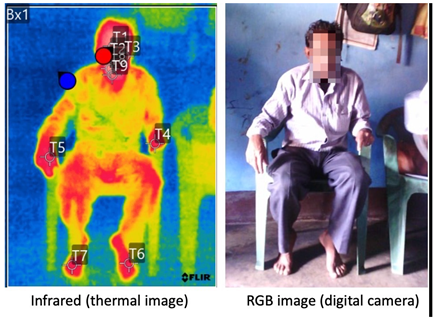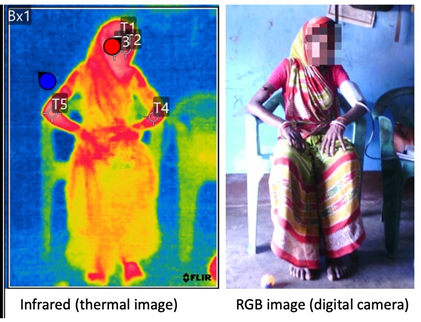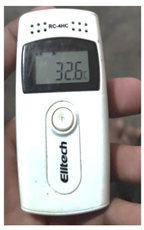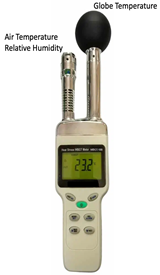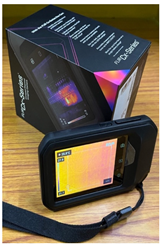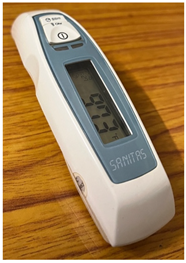Abstract
Optimum indoor humidity is often associated with comfort and overall well-being. Occupant comfort is often evaluated with a focus on “thermal comfort” using the PMV (predicted mean vote), PDD (predicted percentage of dissatisfied), and adaptive thermal comfort models. Humidity-determined comfort parameters, like skin and respiratory comfort, are well acknowledged in the scientific community, but strangely not considered for indoor comfort computations. This study proposes a new computational approach for describing and evaluating humidity-related skin comfort in buildings using skin temperature, evaporative loss, and skin wettedness as critical parameters. The Development and validation of the computational model was demonstrated through a case study in a rural Indian context. The case study involves real-time monitoring of indoor environmental parameters and humidity-determined occupant comfort votes recorded through a novel aggregated humidity comfort vote method. The simulation results were compared with the community comfort/health survey. It was observed that, even at neutral skin temperatures, an increase in skin wettedness increases the thermal sensation vote. Clothing varies according to gender, community, and personal preferences, influencing physiological parameters which determine comfort. The acceptable humidity ratio was found to be in the range of 17.4 to 22.6 g-wv/kg-da for Indian participants. Including humidity-related comfort parameters in building simulation tools would aid in selecting building materials for improved indoor comfort.
1. Introduction
Building design (material, geometry) determines the functional performance of a building to provide occupants with structurally safe and environmentally conducive spaces, ensuring a comfortable, productive, and healthy life. Indoor air parameters like temperature, relative humidity [], pollutants [,,], etc., as well as anthropogenic activities, determine the indoor environmental quality (IEQ) [,,,,,,], significantly impacting comfort, health, and productivity.
Thermal comfort is an essential criterion for the design of buildings, as it is directly associated with occupants’ comfort and energy consumption [,]. Humidity in the air is critical for vital physiological processes which ensure life [,]. Absolute humidity in the air is reported as the humidity ratio, i.e., weight of water vapor per unit weight of dry air. Very low HR can cause skin dryness, itching, and respiratory difficulties among occupants []. In buildings, very high HR can drive the growth of mold [,], resulting in sick building syndrome. Humidity is a significant contributor to latent heating/cooling loads in a building. The thermal comfort votes of occupants implicitly account for humidity-manifested temperature sensation in most thermal comfort studies. Still, humidity-specific discomforts like skin dryness and respiratory difficulties remain overlooked in design for indoor comfort [,,]. This article’s focus is to account for the role of indoor humidity in determining indoor comfort.
Initial studies on thermal comfort in buildings were limited to the discussion of temperature []. Pettenkofer [], in the early 19th century, proposed regular bathing and changing of clothes for regulation of body heat, also highlighting the importance of indoor air quality from a general health and hygiene perspective. However, in occupational environments, extreme heat stress was discussed quantitatively in 1905 [] when the concept of wet-bulb temperature was introduced. The wet-bulb temperature indicates potential evaporative heat loss (water vapor loss) from the human body, accounting for the environmental water vapor saturation. Humidity is often associated with indoor air quality (IAQ), other than its manifestation in increased thermal response. Though humidity remains acknowledged in the literature as a determinant of comfort related to thermal and skin responses, not many studies have been conducted since the 1990s to evaluate its impact explicitly. The study methods adopted in previous studies involved intrusive measurements associated with skin temperature, evaporative heat loss, water consumption, rectal temperature, etc., in controlled environments. Such methods pose a limitation as the responding participant may be self-conscious and not at ease; thus, the effects of cultural, social, and personal (lifestyle) parameters would be difficult to capture. Studies have reported varying responses of occupants regarding comfort [], resilience, and productivity [,,] when living in different building typologies, with varying lifestyles and personal attributes [,].
A series of studies [,,,,,,] focusing the human body’s heat and mass flow principles formed the fundamental grounds for the complex thermo-physiological model (presently called the Gagge model) [] used in varied biomedical, meteorological, and space applications apart from built environment studies.
Fanger stated that the human body strives towards thermal equilibrium, proposing the human body heat exchange theory [,]. As per Fanger’s model, the thermal sensation of human beings is neutral if the rate of heat production and heat loss in the body are in equilibrium. Regarding adopting existing models to estimate the sensations of occupants on-field, the responses have been found to differ from the computed values for the same given environmental conditions [,]. In real-time situations, however, human beings are comfortable in a much broader range of temperature conditions, particularly in developing countries [], due to adaptation and acclimatization [,], as has been revealed by numerous empirical studies [,,,,]. Such empirical studies rely on point-in-time questionnaire surveys to accurately represent comfort responses. Such surveys can be performed either in environmental chambers or in real-time conditions. Environmental chamber studies pose a limitation of not precisely replicating the actual environmental living conditions of participants. On-field surveys have been found to be reliable, but are labor-intensive and consume a significant amount of time, as responses are required at different times of the day, in different seasons, and for different age groups. Studies have reported varying responses of occupants regarding comfort [], resilience, and productivity [,,] when living in different building typologies, with varying lifestyles and personal attributes [,].
The objectives of the present study are:
- To develop a non-intrusive, questionnaire-based approach to capture aggregated thermal and skin comfort responses;
- To develop a non-intrusive approach for validating a human thermo-physiological model (2-node, 16-segment) using thermal imagery and a point-in-time indoor environmental survey;
- Demonstration of the developed methodology using a case study in a rural Indian context.
The scope of the present study is limited to the skin and thermal comfort responses regarding environmental and personal (physiological and lifestyle) characteristics (see Figure 1). Also, the case study presented in this article was conducted in a rural Indian context, in Jamgoria village (Jharkhand State, India), situated in a composite climate zone of India [] (humid subtropical-Cwa based on Köppen Geiger Classification), for occupants living in naturally ventilated conventional (Brick/RCC) and vernacular (Earth/Adobe) buildings.
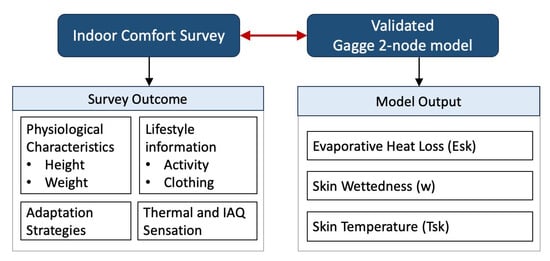
Figure 1.
Overview of the study.
2. Methodology
2.1. On-Field Monitoring of Indoor Environmental Parameters
The indoor air temperature (ti in °C) and relative humidity (RHi in %) were monitored for one year in naturally ventilated vernacular (Earth/Adobe) and conventional (Bring/RCC) building typologies in Jamgoria Village, in our previous studies [,]. This case study was selected because it had various building typologies (see Figure 2) of interest and was accessible. The vernacular building was an 80-year-old structure with 450 mm thick wall constructed of mud, and traditional clay tile roofing. The habitable height of the room was 1.9 m, with an additional 1.7 m high loft space. Also, the habitable area was approximately 8 m2. The conventional building was a newly constructed 2-year-old reinforced cement, concrete-based, framed structure, with walls 250 mm thick (225 mm fired-clay brick walls, with cement plaster on both the interior and exterior surfaces). The approximate habitable height of the room and habitable area were 3.1 m and 9 m2, respectively. Both of the rooms had similar occupancies. Ventilation has a huge impact on indoor ti and RHi. Since the purpose of the study was to examine the role of building-material-based typology on indoor ti and RHi variation, windows were kept closed all the time to ensure minimum air exchange with the outdoor environment. It was observed that the indoor thermal environments varied according to different building typologies, determining comfort. This article primarily deals with examining indoor comfort (thermal and skin). Indoor ti and RHi data for different seasons from different building typologies were used as inputs for the simulations performed in this study.

Figure 2.
Case study buildings in Jamgoria Village.
2.2. Indoor Comfort Survey
In our previous studies [,], we found that, irrespective of the thermal conditions, occupants tend to have varying thermal expectations as marked by different cultural events and festivals that recur every year. This led to the formulation of a new approach to examine the thermal responses of occupants, especially dealing with people of diverse ethnicities and cultural backgrounds.
The thermal expectations/preferences of the community were marked by varying community practices according to by local festivals in that community. Local festivals marked changes in food habits, clothing patterns, and cultural practices, which were found to be clear indicators of the thermal expectations of occupants. This inference was found to be very useful in the process of customizing the questionnaire for the community. Also, occupants were found to relate to the festivals, and expressed their thermal experiences and expectations based on how they changed their everyday activities. This approach also helped us to investigate the comfort expectations of occupants in a non-intrusive manner, wherein their involvement in the conversation was primary. The local festivals and associated cultural practices were examined in detail in the context of thermal comfort for incorporation into the questionnaire.
This approach is an extension of an early study by our group [] examining humidity-related comfort. It involved designing a questionnaire (Appendix A: Indoor Comfort Survey) to capture the aggregated comfort votes of occupants based on a Likert scale. The thermal sensation votes (TSV) ranged from very cold (−3) to very hot (3), and the indoor air quality/skin sensation votes ((IaqSV) very dry (−2) to sticky (2)) were obtained based on the thermal experiences of participants in different months, seasons, and festivals.
The questionnaire survey was conducted in Jamgoria Village for 62 participants, 30 (M = 13, F = 17) residing in vernacular and 32 (M = 18, F = 14) in conventional dwellings. They were aged 22–71 years and resided in Jamgoria village in the eastern state of Jharkhand, India. The community was involved in agriculture and construction as their primary occupation. The participants were asked to be seated and relaxed while the survey was explained verbally in the local language before their responses were noted.
The aggregated comfort votes of the participants were sought for different months of the year, corresponding to local events/festivals. Physiological parameters (height and weight), vital health parameters (heart rate, blood pressure), and thermal imagery of the participants were recorded. The physiological parameters of the participants, like weight and height, were measured using a standard commercial scale (see Figure 3). The occupants’ heart rates and blood pressure (BP) were recorded using a medical grade, commercially available BP monitor (see Figure 3) to ensure a relaxed state during the survey. Also, recent studies have reported an inverse association between BP and skin temperature [,]. As the skin temperature values were used for the model’s validation, it was essential to measure BP to ensure that participants would have normal BP and skin temperatures. The thermal images of the occupants were captured using a portable thermal imager (see Table 1). Simultaneously, a point-in-time thermal comfort survey was conducted while recording the in situ ambient air temperature, relative humidity, and globe temperature with a heat stress meter. It was ensured that all windows in the room were closed and that the fan was turned off during the survey to maintain minimum air exchange. The recorded air velocities were always below 0.05 m/s. The technical details of all the instruments are tabulated in Table 2.
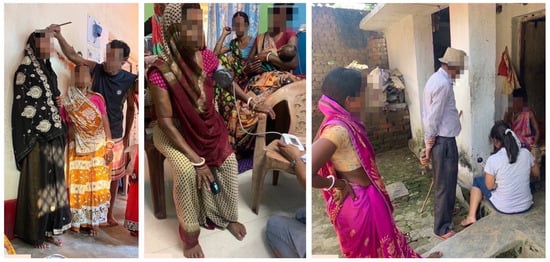
Figure 3.
Field measurements and comfort survey of participants in Jamgoria village.

Table 1.
Thermal images of survey participants and corresponding readings.

Table 2.
Details of instruments used in the study.
2.3. Simulation Model
2.3.1. Energy Balance of the Human Body (Core–Skin–Indoor Air)
In this study, to determine the response of the human skin (skin temperature, evaporative losses, and skin wettedness) to indoor ambient conditions (air temperature, relative humidity, radiation, and wind), the “Gagge 2-node model” [] was adopted. This is an energy balance model describing the human body–air interaction.
The model considers the human body to be made up of 16 cylindrical segments representing different body parts, each comprising two nodes (core and skin), as shown in Figure 4. In this study, the Gagge model was modified based on the physiological parameters of the Indian participants (data from the survey). The constants of the model representing an average human being, i.e., segment-wise neutral skin and core temperatures [], segment mass and DuBois area proportions [], and segment-wise heat transfer coefficients [], were taken from the literature []. The mass, height, and DuBois area of the individual segments of each survey participant were calculated, maintaining the proportions of an average human being (see Table 3) for modeling purposes.
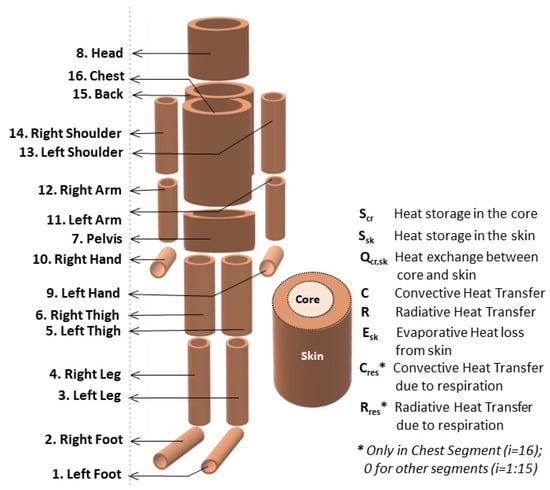
Figure 4.
Segments of the human body in the 2-node, 16-segment Gagge model.

Table 3.
Average physiological characteristics of the survey participants.
The fundamental working principle of the model is based on the argument that the neutral core body temperature remains constant. Any perturbance in the surrounding thermal environment triggers the human body’s heat exchange (loss or gain through the skin) to maintain the core temperature. To solve for the energy balance between the core and the skin, heat storage in each of them was expressed for each segment as
Scr and Ssk represent the heat storage in the core and skin, respectively; in W/m2. M and W correspond to metabolic heat production and heat due to external work in W/m2, respectively. Qcr,sk represents the heat flow from the core to the skin in W/m2. C and R are the convective and radiative heat transfer in W/m2, respectively. Also, corresponds to the energy required for respiration in W/m2, applicable only for the chest segment, given by
Here, to is the air temperature in °C (equal to the measured indoor temperature ti in °C). pwv,a is the partial pressure of water vapor in the air in kPa. The rate of change of internal energy in the core and the skin as a function of temperature change is given by
Here, is the dimensionless body mass fraction at the skin, m is the segmental mass in kg. cp,b is the constant pressure specific heat of tissue in KJ/kgK, and is time in s. A is the body segment surface area in m2. The convective and radiative heat losses from each of the body segments in W/m2 and the exchange from the core to the skin and vice versa are given by
tsk is the skin temperature in °C, and Rt is the total thermal resistance in m2°C/W. Convective heat transfer coefficients for each segment were obtained from []. Evaporative heat loss due to mass transfer between the skin and ambient air, as well as heat transfer from the core of the body to the skin, are given by
Here, Esk stands for evaporative heat loss from the skin in W/m2, and w is the skin wettedness ratio (dimensionless). Psk,s is the partial pressure of saturated air at tsk in kPa. Re,t is the total evaporative resistance in m2kPa/W.
Also, K is the effective conductance between the skin and the core in W/m2K. cp,bl is the constant pressure-specific heat of blood in kJ/kgK, and mbl is the blood flow from the core to the skin in kg/m2s. Also, tcr is the core body temperature in °C. The total thermal resistance (Rt) and evaporative resistance (Re,t) were calculated for different clothing patterns based on the preferences of the participants, according to their gender and building typology, using data obtained from the field survey.
The data on fabric properties were obtained from []. Ra and Ral correspond to the thermal resistance of the outer air layer and the intermediate air layer in m2°C/W, respectively. Re,a and Re,al are the evaporative resistance of the outer air and intermediate air layer in m2kPa/W, respectively. Rf is the thermal resistance of the fabric layer in m2°C/W, and Re,f is the evaporative resistance of the fabric layer in m2kPa /W, respectively. For the analysis presented here, to is taken to be the same as ti, as the differences between the air temperature and mean radiant temperature in these dwellings were not significant. Relative humidity (RHi), in %, was used to calculate the partial pressure of ambient air (pwv,a). M (Metabolic Rate) and W (Heat produced due to activity) were taken as 60 and 30 W/m2, respectively. Simulations have been performed to derive the tsk, Esk, and w corresponding to diurnally and seasonally varying indoor conditions in both conventional and vernacular building typologies.
2.3.2. Experimental Validation
In previous studies, the experimental validation of thermo-physiological models was carried out by examining human participants in controlled chambers for skin temperature in different environmental conditions. This, however, does not replicate real-life conditions, with the occupants being completely normal.
In this study, a new approach was followed to validate the model’s output with skin temperatures obtained from thermal imagery of the participants (see Figure 5). The skin temperatures of 34 healthy participants (Male = 13, Female = 21) were measured using a thermometer, followed by capturing thermal images. The temperatures reported in the thermal images were validated by means of the thermometer readings. The ranges of ambient air temperature, globe temperature, wet bulb temperature, and relative humidity were 28.8~31.2 °C, 29.6~34 °C, 27.4~29.7 °C, and 69.3~88%, respectively, during the collection of the thermal imagery.
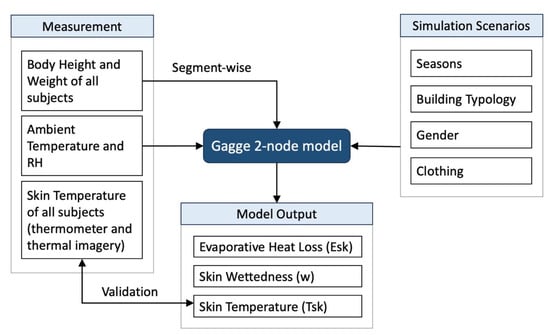
Figure 5.
Methodology followed to validate the Gagge model and simulation.
Thermal imagery of the seated occupants was captured from a distance of approximately 12 m from the imager (camera). The captured images were also shown to the participants while the nature of the image was explained. The thermal images were adjusted for the emissivity value of human skin, ~0.95 []. Only the values of skin temperature tsk for parts of the body not covered by clothes were used for the validation. The model was run for environmental conditions (ti, RHi), recorded on the field during the point-in-time survey. The physiological characteristics of each occupant were used for the simulation. The skin temperature [tsk] values were compared segment-wise (see Table 1); however, the average tsk for the recorded values was used to validate the model. The aggregated physiological characteristics of the survey participants are tabulated in Table 3.
The correlation coefficient (R2 = 0.73) between the tsk from the simulation and that from the experiment (thermal imagery) is shown in Figure 6. The deviation (R2 < 1) may have occurred due to variations in physiology (metabolism and activity) and health conditions or body constitution at that point in time. The observed variation could also have been due to constant values of heat transfer coefficients used in the simulations and variations in the emissivity of the skin values input into to the instrument (kept constant in the thermal image).
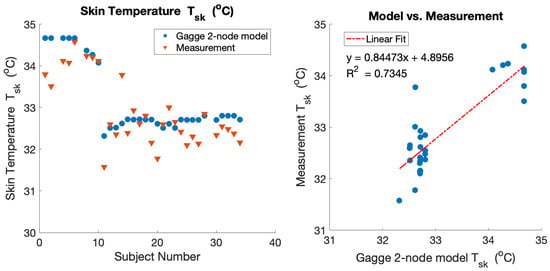
Figure 6.
Validation of simulated results with measurements.
3. Results
3.1. Indoor Comfort Survey
3.1.1. Thermal Sensation
Jamgoria Village is situated in the composite climate zone of India, 2005 [], and is classified as humid subtropical (Cwa) based on the Köppen Geiger Classification. The three major seasons are winter (October, November, December, January, February), summer (March, April, May), and monsoon (June, July, August, September). Figure 7 shows the environmental parameters recorded during the survey for occupants of varying ages and genders residing in different building typologies with their point-in-time thermal comfort votes. The majority of females residing in vernacular dwellings reported neutral thermal sensation votes during the survey.
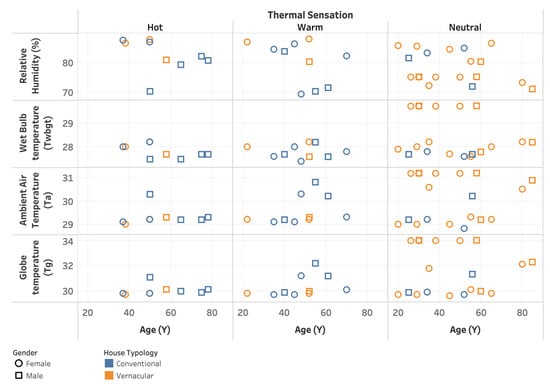
Figure 7.
Indoor environmental conditions during point-in-time survey.
The thermal sensation (TSV) of the occupants ranged from very cold (−3) to very hot (+3) from the winter to the summer months. This was well captured using the aggregate comfort survey approach. Figure 8 and Figure 9 show the aggregated comfort votes of occupants both monthly and seasonally. Amongst the participants, the occupants residing in vernacular buildings showed more acceptability for higher temperatures, reporting a mean summer TSV = (+0.2) and a mean monsoon TSV = (+1.5) (see Figure 8). The conventional group reported a mean summer TSV = (+0.7) and a mean monsoon TSV = (+1.7). The mean winter TSV was comparable for both groups, (−1.5) and (−1.6) for conventional and vernacular, respectively, as shown in Figure 9. With limited data availability for the gender groups, it was observed that women in vernacular dwellings were particularly more resilient towards higher temperatures. This could result from the low BMIs and active indoor lifestyles commonly observed in Indian households. All the interviewed participants were involved in an active lifestyle on a daily basis. However, within the group of participants, the intensity of activity varied. The vernacular group reported being more active throughout the day in comparison to the conventional group.
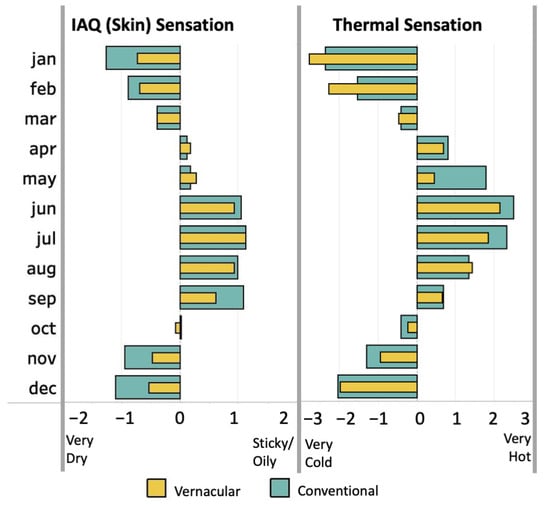
Figure 8.
Aggregated IaqSV and TSV for different months.
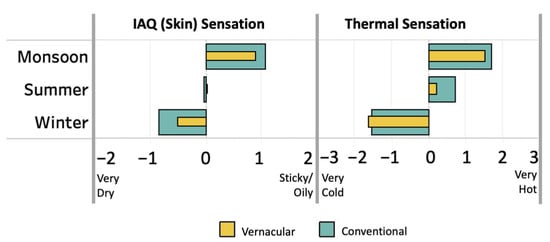
Figure 9.
Aggregated IaqSV and TSV for different seasons.
3.1.2. Indoor Air Quality (Skin) Sensation
The IAQ (skin) sensation votes (IaqSV) varied from very dry (−2) during the winter months to very sticky (+2) during the monsoon months. The same trend was noticed with the sensation votes averaged for months seasonally. The mean IaqSV also varied between the conventional and vernacular groups. The mean winter IaqSV = (−0.8) and IaqSV = (−0.5) were reported for the conventional and vernacular groups, respectively. It indicates that the participants feel a sensation of dry skin during the winter months. Similarly, mean monsoon IaqSV = (+1.1) and IaqSV = (+0.9) were reported for conventional and vernacular groups, respectively, indicating a sticky, clingy sensation on the skin. Overall, the months of March and October were found to be comfortable both for thermal and IAQ (skin) comfort.
3.1.3. Adaptation and Clothing
All the participants lived in naturally ventilated dwellings, without air-conditioning units installed in the houses. Also, 16% of the total participants (all vernacular) lived in dwellings with no fans installed. As shown in Figure 10, the adaptation strategies indicate that most participants prefer to turn on fans, open windows, and alter their clothing to feel comfortable indoors during the summer and monsoon seasons. Other strategies involved drinking more water and frequent bathing (more often during the monsoon season due to sticky skin). During the cold months, the occupants preferred to change clothing and drink hot beverages. Occupants living in vernacular dwellings, in particular, used portable coal-based stoves to cook in the living areas, helping to automatically warm up the space. Changing clothing was the most consistent adaptation strategy during all seasons.
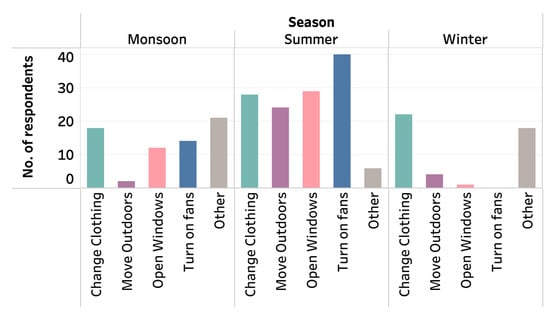
Figure 10.
Different adaptation strategies reported in the survey for comfort.
Within the same community, the clothing patterns were different amongst the vernacular and conventional groups, as shown in Figure 11. Men in the vernacular group were mostly observed dressed in a traditional “dhoti” or “lungi”, which is a long cloth made of mostly cotton fabric covering the body below the waist with a vest. However, men in the conventional group were mostly observed dressed in full-arm shirts and full trousers throughout the day. Women in both groups dressed in traditional Indian “saree”, a long cloth draped around the body with a petticoat and blouse. However, the vernacular group used cotton fabric, and the conventional group used synthetic fabric for the sarees. The clothing patterns were mostly reported to be consistent throughout the year, with the addition of a woolen shawl during the colder months by men and women in both groups.

Figure 11.
Typical clothing characteristics of survey participants.
3.2. Simulation Results
Simulations using the validated Gagge model were performed for four groups of participants, namely, vernacular male (VM), vernacular female (VF), conventional male (CM), and conventional female (CF), accounting for their gender, physiology (height and weight as mentioned in Table 3), clothing, and the building typology in which they resided. These scenarios were simulated with on-field measured ti and RHi values as inputs for the model corresponding to building typologies (vernacular and conventional) (see Figure 12). The clothing resistances (thermal and evaporative) were computed for different scenarios based on the clothing details, as shown in Figure 11, using fabric resistance, thickness, and air layer values adopted from the literature [,]. The results are shown in Table 4.
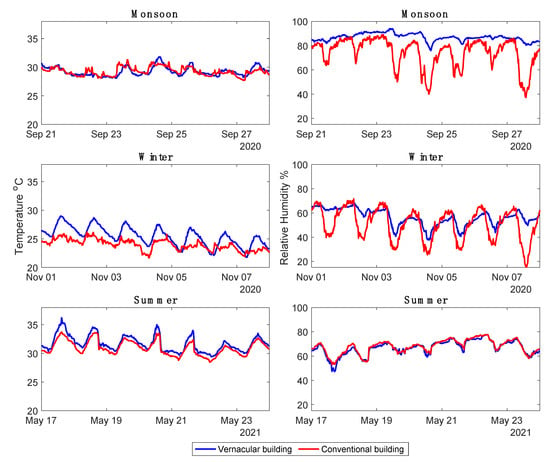
Figure 12.
Indoor air temperature and humidity profiles for typical monsoon, winter, and summer weeks in conventional and vernacular rooms.

Table 4.
Segment-wise thermal resistance (Rt in m2°C/W) and evaporative resistance (Re,t in m2kPa/W). Highlighted cells indicate no fabric resistance (only air layer resistance is applicable).
3.3. Skin Temperature
Figure 13 shows the variations in mean skin temperature (tsk), total evaporative losses (Esk), and mean skin wettedness (w) of participants for a typical week during the summer, monsoon, and winter seasons. Similarly, Figure 14 shows the variations in tsk, Esk, and w of the participants for a typical day during different seasons. The human body strives to attain thermal equilibrium through heat exchanges with the environment. A higher tsk indicates that the body wants to release excess heat through heat and mass exchanges. As seen in Figure 13, the tsk was higher in summer than the neutral tsk, suggesting a need for heat loss, and lower than the neutral tsk in winter, suggesting a need for heat gain. The mean tsk values of occupants in the community were 34.04 °C, 29.53 °C, and 36.04 °C in the monsoon, winter, and summer seasons, respectively. Amongst the occupants, the tsk values of the VF and VM groups were almost identical in all seasons. The mean tsk values of VF and VM were significantly higher than for the CF and CM groups in the winter, by 1.38 °C. Clothing preferences could be a reason for this variation, as cotton fabric has a higher resistance to heat loss and acts to keep the tsk closer to neutral during the winter.
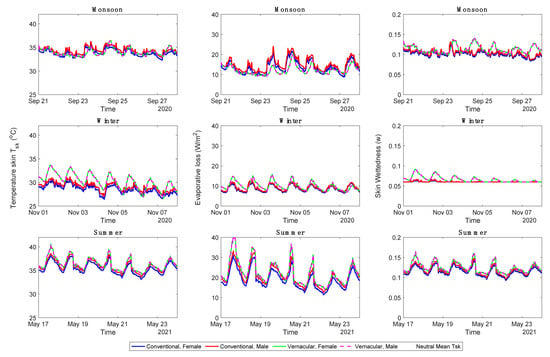
Figure 13.
Seasonal variations in tsk, Esk, and w in simulation scenarios for a typical week.
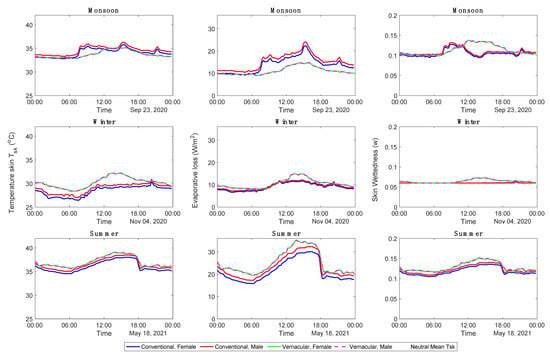
Figure 14.
Seasonal variations in tsk, Esk, and w in simulation scenarios for a typical day.
3.3.1. Evaporative Loss and Skin Wettedness
The mean Esk values were reported to be 13.23 W/m2, 9.42 W/m2, and 21.08 W/m2 in the monsoon, winter, and summer seasons, respectively. The mean w values were 0.108, 0.063, and 0.121 in the monsoon, winter, and summer seasons, respectively. Even though the tsk in the winter was lower than the neutral tsk, the Esk was greater than 0. This implies that latent heat/water vapor loss could result from the low humidity, which eventually causes heat loss and a further drop in tsk. Amongst the different scenarios, VF and VM showed lower Esk values during the monsoon season than CF and CM. This could be because of the high evaporative resistance and moisture sorption of the cotton fabric. Further, with the high evaporative resistance of the clothing in VF and VM, moisture retention by the fabric can be seen, resulting in higher w values during the winter and avoiding excessive moisture loss from the skin.
3.3.2. Effect of Clothing
Figure 15 shows the differences in tsk, Esk, and w due to clothing. The tsk difference was at its highest in CM group, approximately 1.6 °C higher compared to the unclothed scenario in the computational model. The lowest difference was seen in CM. This is a result of the low thermal resistance of poplin fabric compared to cotton. Heat retention due to the greater body surface area covered with clothing in the CM group compared to VF, VM, and CF groups is another determinant of the greater difference in tsk due to clothing. The differences in tsk for different scenarios were comparable: ~1.21 °C, ~1.22 °C, ~1.05 °C, and ~1.57 °C in VF, VM, CF, and CM, respectively, in all seasons. The differences in Esk due to clothing followed a similar trend to the difference in tsk; however, the increased Esk difference due to clothing during the afternoon in winter indicated the moisture retention of the fabric, which inhibited moisture loss. The differences in w due to clothing were not very significant.
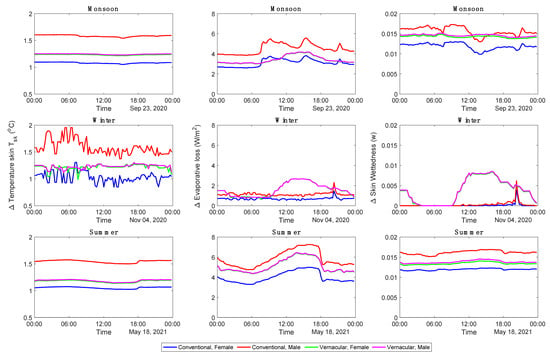
Figure 15.
Differences in tsk, Esk, and w due to clothing in the simulation scenarios.
4. Discussions
4.1. Skin Parameters (tsk, Esk, w) vs. Comfort Response
Skin temperature was found to be directly associated with thermal response, specifically during the winter months. The difference between tsk and neutral tsk determines the thermal discomfort. However, at tsk values above neutral skin temperatures, the thermal sensation was higher, even at a lower tsk, for similar values of w. It can be observed that the TSV was higher during the monsoon season when compared to summer, even though the mean tsk in the monsoon season was comparable to the neutral tsk. Therefore, skin wettedness (or sweat accumulation) could be a critical parameter indicating restricted heat loss. Many studies have reported similar observations [,,]. High-humidity environments restrict the water vapor loss from the human body. Therefore, when accompanied by higher temperatures, restricted water vapor loss and excess heat storage in the body result in rising core body temperature and can be fatal.
Also, these conditions could cause discomfort due to sweat accumulation, causing a sensation of “clinginess” [,,,]. Adaptation strategies during the monsoon season include increasing the ventilation in high-humidity environments (with fan or opening windows) and frequent bathing. Participants reported that bathing frequently relieved them from the “sticky” skin and also helped them to attain a cooling sensation. Therefore, it is imperative that high moisture levels be avoided for improved thermal as well as skin-related comfort.
However, minimizing moisture levels could result in other issues associated with dryness of the skin, eyes, respiratory tract, etc., leading to health-related problems. In this study, it was also noted that during the winter, the tsk was lower, and the body needed to retain heat. Low humidity levels outdoors caused water vapor transport from the skin (saturated) to the outdoor air, indicated by a positive Esk, drying up the skin and reducing thermal comfort.
4.2. Effects of Gender, Clothing, and BMI
Humans adapt to their thermal environments through modifications in daily activities, diet, clothing, etc. Also, the physiologies of various populations are suited to the external environments in which they live. Cultural practices and occupations also have a role in determining thermal expectations and resilience. Therefore, there is a different psychological sensation of comfort from individual to individual. However, a broad level of consensus in thermal comfort could be explained through physiological heat gains/losses and factors promoting/inhibiting it. In this study, it was observed that the thermal responses of the occupants varied within a community based on their indoor living environments (house typologies), body mass and height, and clothing practices. Table 5 summarizes the physiological parameters (tsk, Esk, and w) corresponding to the TSV and IaqSV values (psychological response) within different groups of survey participants in Jamgoria Village. Vernacular dwelling conditions during the summer months were reported to be more acceptable in terms of both TSV and IaqSV.

Table 5.
Summary of comfort votes regarding physiological parameters.
4.3. The Case of Optimum Indoor Humidity: Literature vs. Present Study
The functional performance of a dwelling is to maintain indoor conditions conducive to occupants’ comfort, productivity, and health. The challenge is to achieve optimal humidity, because too little can cause serious diseases such as breathing problems, yet too much can cause skin discomfort, irritation, etc. [,,,,]. Recommendations on humidity levels for optimal IAQ are inconsistent in the literature and do not consider diversity in ethnicity, physiology, etc. A graph showing the relation of growth of bacteria, viruses, dust mites, etc., with relative humidity can be found in [,], stating relative humidity between 40–60% to be the optimum, which has been widely cited in all relevant studies.
However, the temperature conditions associated with each of these ranges are not very clear. Also, their relationship with humidity has been shown to be linear, and has not been validated with experimentation or empirical studies.
In 2017, the ASHRAE-55 [] recommendations for optimum humidity levels were reported in terms of a humidity ratio (HR = 0.012 kg-wv/kg-da) (earlier recommendations were made in terms of RH). As the humidity ratio considers the effect of temperature and RH simultaneously, it may be easy in terms of practical implementation and assessment. Humidity ratios, calculated corresponding to the optimum temperature/RH recommendations from [,,,,,], are shown in Figure 16. However, none of these studies have been conducted for Indian conditions to account for varying physiologies and relevant adaptation strategies. The optimal HR corresponding to acceptable thermal and IAQ (skin) sensation was noted in the summer conditions in vernacular participants (see Table 5). The corresponding environmental conditions, and the associated humidity ratios, are shown in Figure 17 and Figure 18. It was found that the acceptable ranges of HR varied in the range of 17.4 to 22.6 g-wv/kg-da.
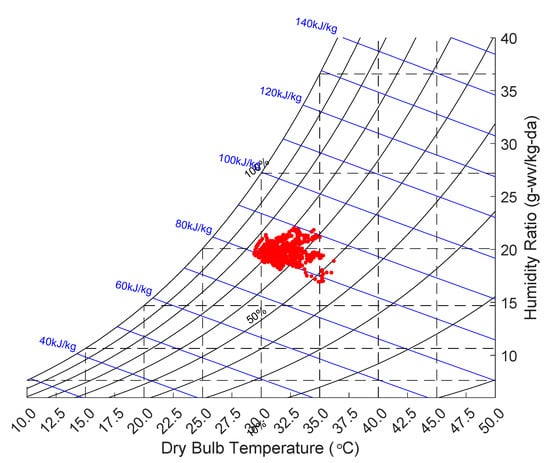
Figure 17.
Environmental parameters corresponding to satisfactory conditions for thermal and IAQ (skin) comfort in this study.
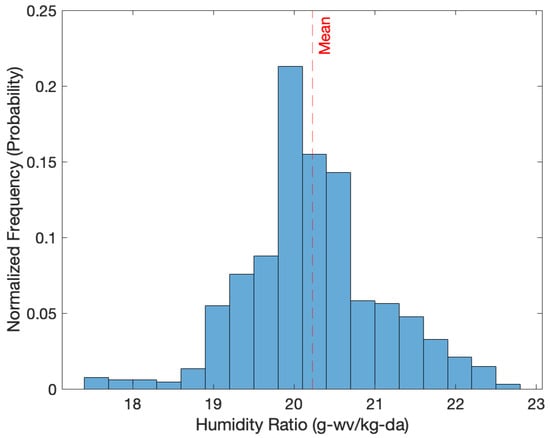
Figure 18.
Acceptable ranges of HR for thermal and IAQ (skin) comfort reported in this study.
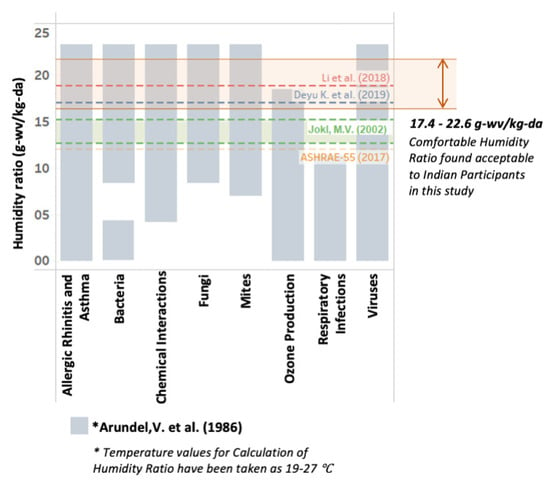
Figure 16.
Computed comfort humidity ratio using comfort temperature and relative humidity values recommended in [,,,,].
It must be noted that, even with the same external environment, clothing characteristics can significantly modify the associated physiological parameters and alter comfort perception. As shown previously, the cotton fabric used by the occupants of vernacular dwellings aided in buffering heat and moisture losses in winter. Therefore, for all practical purposes, examining tsk, Esk, and w in conjunction with clothing is critical. The environmental parameters can only be indicative of broad-level comfort votes.
5. The Way Forward—Use of the Proposed Methodology and Limitations
The methodology proposed in this article constitutes a non-intrusive method by which to examine indoor environments for comfort. State-of-the-art wearables like watches can be used to obtain continuous skin temperature and evaporative heat loss data for occupants of varying ethnicities, genders, climate zones, and building typologies. These data can be used to validate the simulation model proposed in this article and can aid in personalized indoor comfort design.
Presently, adaptive models for thermal comfort indicate environmental temperature as the most critical parameter determining comfort. Also, conventional indices used for indoor comfort evaluation, like PMV and PDD, capture the “qualitative psychological response”; however, they do not accurately demonstrate the underlying causal factors. The approach presented in the current study involves multiple quantifiable parameters pertaining to both the environment (input—indoor temperature, relative humidity) and occupant (input—height and weight; output—skin temperature, evaporative heat loss, and skin wettedness), which can potentially explain indoor comfort quantitatively. Additionally, incorporating skin temperature and wettedness could provide valuable insights into skin-related comfort in varying thermal environments. This methodology can be integrated with personalized heating/cooling systems through IOT interfaces with mobile apps to predict possible discomforts. Also, the results obtained in this study call for a more detailed investigation into humidity regulation in buildings. In addition to PMV and PDD, an additional plugin accounting for occupant physiology (height and weight) and clothing could be added to building simulation tools to provide more insights into the parameters determining comfort and to explicitly account for humidity-related comfort.
The case study presented in this article is limited to an Indian rural community. Given the diversity of ethnicities, living environments offered by varying building typologies, and cultural practices, there is a vast scope for experimental work in this area. Also, the simulation approach presented in this article was validated for limited participants and environmental conditions. Similar studies need to be conducted for varying climate zones and building typologies, accounting for diverse occupant physiologies. These studies are required in order to enhance the accuracy of such models for better comfort predictions.
6. Conclusions
A non-intrusive, questionnaire-based approach to capture aggregated thermal and skin comfort responses was developed. The aggregated comfort survey was conducted in a rural Indian context. Also, a thermo-physiological model of the human body was validated for the same Indian participants using a novel, non-intrusive approach. For validation, on-field experiments were carried out to obtain the physiological (height and weight) and skin temperature (through thermometer and thermal imagery) data of the participants in their everyday living environments.
The results obtained through the aggregated comfort survey were examined through the simulation results (skin temperature, evaporative heat loss, and skin wettedness), accounting for occupant physiology (height and weight), age, gender, activity level, and building typology in which they reside.
Skin temperature and skin wettedness were found to be important indicators concurrently determining thermal and IAQ-related comfort. It was found that clothing is an important adaptation strategy directly impacting physiological parameters (skin temperature and wettedness), thereby impacting comfort. Also, the acceptable range of humidity ratio in the Indian context was found to be 17.4 to 22.6 g-wv/kg-da. This study highlights the importance of examining humidity explicitly for comfortable indoor environments. Research into building design and material selection for optimum humidity could be aided by incorporating this approach into existing building simulation tools.
Author Contributions
Conceptualization, S.P., R.R.R. and M.M.; data curation, S.P.; formal analysis, S.P.; funding acquisition, S.P., M.M. and D.M.; investigation, S.P.; methodology, S.P., R.R.R. and M.M.; software, S.P. and R.R.R.; supervision, M.M. and D.M.; Validation, S.P. and R.R.R.; visualization, S.P.; writing—original draft, S.P.; writing—review and editing, S.P., R.R.R., M.M. and D.M. All authors have read and agreed to the published version of the manuscript.
Funding
Part of this research was supported by The British Academy’s Well-being Achieved from Earthen Residence (WAFER) project (UWB190086) and partly through the Prime Minister’s Research Fellowship, India.
Institutional Review Board Statement
The study was approved by the Institutional Human Ethics Committee (IHEC) at Indian Institute of Science, Bangalore, India. Informed consent was obtained from all human participants involved in this study.
Data Availability Statement
Research data will be shared upon request.
Conflicts of Interest
The authors declare no conflict of interest. The funders had no role in the design of the study; in the collection, analyses, or interpretation of data; in the writing of the manuscript; or in the decision to publish the results.
Appendix A. Indoor Comfort Survey Questionnaire
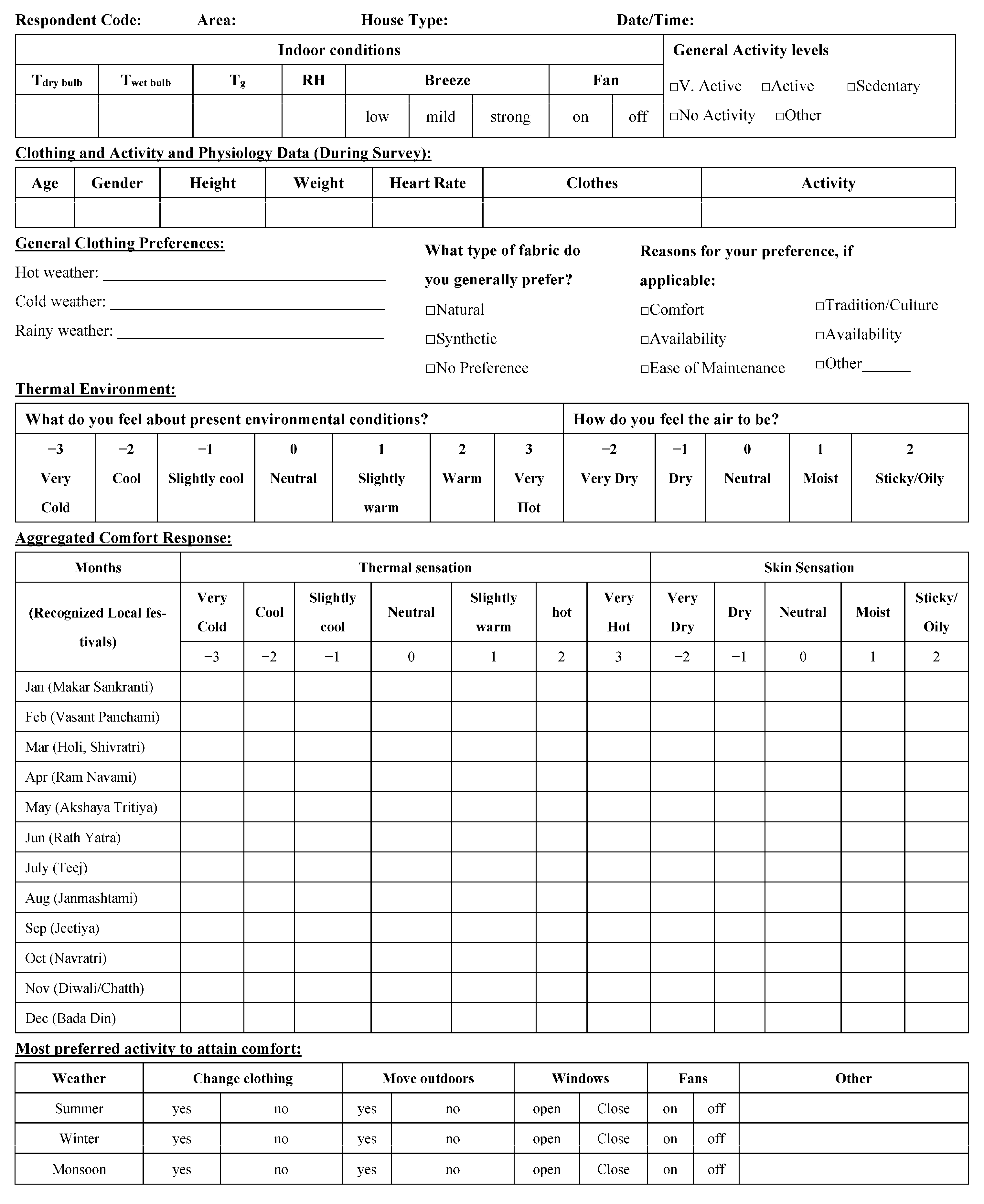
References
- Wallner, P.; Tappler, P.; Munoz, U.; Damberger, B.; Wanka, A.; Kundi, M.; Hutter, H.-P. Health and Wellbeing of Occupants in Highly Energy Efficient Buildings: A Field Study. Int. J. Environ. Res. Public Health 2017, 14, 314. [Google Scholar] [CrossRef] [PubMed]
- Fung, F.; Hughson, W.G. Health Effects of Indoor Fungal Bioaerosol Exposure. Appl. Occup. Environ. Hyg. 2003, 18, 535–544. [Google Scholar] [CrossRef]
- Arundel, A.V.; Sterling, E.M.; Biggin, J.H.; Sterling, T.D. Indirect health effects of relative humidity in indoor environments. Environ. Health Perspect. 1986, 65, 351–361. [Google Scholar] [CrossRef] [PubMed]
- Markowicz, P.; Larsson, L. Influence of relative humidity on VOC concentrations in indoor air. Environ. Sci. Pollut. Res. 2015, 22, 5772–5779. [Google Scholar] [CrossRef] [PubMed]
- Petty, S.E. Indoor environmental quality. In Forensic Engineering: Damage Assessments for Residential and Commercial Structures; CRC Press: Boca Raton, FL, USA, 2017; pp. 421–436. [Google Scholar] [CrossRef]
- Hodgson, M. Indoor environmental exposures and symptoms. Environ. Health Perspect. 2002, 110 (Suppl. S4), 663–667. [Google Scholar] [CrossRef]
- Wallner, P.; Munoz, U.; Tappler, P.; Wanka, A.; Kundi, M.; Shelton, J.F.; Hutter, H.-P. Indoor Environmental Quality in Mechanically Ventilated, Energy-Efficient Buildings vs. Conventional Buildings. Int. J. Environ. Res. Public Health 2015, 12, 14132–14147. [Google Scholar] [CrossRef]
- Sahlberg, B.; Mi, Y.-H.; Norbäck, D. Indoor environment in dwellings, asthma, allergies, and sick building syndrome in the Swedish population: A longitudinal cohort study from 1989 to 1997. Int. Arch. Occup. Environ. Health 2009, 82, 1211–1218. [Google Scholar] [CrossRef]
- Peeters, L.; de Dear, R.; Hensen, J.; D’haeseleer, W. Thermal comfort in residential buildings: Comfort values and scales for building energy simulation. Appl. Energy 2009, 86, 772–780. [Google Scholar] [CrossRef]
- de Dear, R.; Brager, G.S. The adaptive model of thermal comfort and energy conservation in the built environment. Int. J. Biometeorol. 2001, 45, 100–108. [Google Scholar] [CrossRef]
- Davis, R.E.; McGregor, G.R.; Enfield, K.B. Humidity: A review and primer on atmospheric moisture and human health. Environ. Res. 2016, 144, 106–116. [Google Scholar] [CrossRef]
- Wolkoff, P. Indoor air humidity, air quality, and health—An overview. Int. J. Hyg. Environ. Health 2018, 221, 376–390. [Google Scholar] [CrossRef] [PubMed]
- Hamehkasi, M. Effects of Low Humidity on Comfort, Health and Indoor Environmental Quality: A Literature Review. Ph.D. Thesis, Kansas State University, Manhattan, KS, USA, 2016. [Google Scholar]
- Ahmed, T.; Usman, M.; Scholz, M. Biodeterioration of buildings and public health implications caused by indoor air pollution. Indoor Built Environ. 2018, 27, 752–765. [Google Scholar] [CrossRef]
- Burger, H. Bioaerosols: Prevalence and health effects in the indoor environment. J. Allergy Clin. Immunol. 1990, 86, 687–701. [Google Scholar] [CrossRef] [PubMed]
- Hugentobler, W. Mucociliary clearance is humidity dependent-contrary to common belief. In Proceedings of the 17th International Healthy Buildings Conference, Oslo, Norway, 21–23 June 2021; pp. 66–69. [Google Scholar]
- Toftum, J.; Jørgensen, A.S.; Fanger, P. Upper limits of air humidity for preventing warm respiratory discomfort. Energy Build. 1998, 28, 15–23. [Google Scholar] [CrossRef]
- Toftum, J.; Jørgensen, A.S.; Fanger, P. Upper limits for indoor air humidity to avoid uncomfortably humid skin. Energy Build. 1998, 28, 1–13. [Google Scholar] [CrossRef]
- Cheng, K.C.; Fujii, T. Isaac newton and heat transfer. Heat Transf. Eng. 1998, 19, 9–21. [Google Scholar] [CrossRef]
- Locher, W.G. Max von Pettenkofer (1818–1901) as a pioneer of modern hygiene and preventive medicine. Environ. Health Prev. Med. 2007, 12, 238–245. [Google Scholar] [CrossRef]
- Haldane, J.S. The influence of high air temperatures. J. Hyg. 1905, 5, 494–513. [Google Scholar] [CrossRef]
- Shastry, V.; Mani, M.; Tenorio, R. Evaluating thermal comfort and building climatic response in warm-humid climates for vernacular dwellings in Suggenhalli (India). Arch. Sci. Rev. 2016, 59, 12–26. [Google Scholar] [CrossRef]
- Singh, J. Health, Comfort and Productivity in the Indoor Environment. Indoor Built Environ. 1996, 5, 22–33. [Google Scholar] [CrossRef]
- Al Horr, Y.; Arif, M.; Kaushik, A.; Mazroei, A.; Katafygiotou, M.; Elsarrag, E. Occupant productivity and office indoor environment quality: A review of the literature. Build. Environ. 2016, 105, 369–389. [Google Scholar] [CrossRef]
- Fisk, W. How IEQ Affects Health, Productivity. ASHRAE J. 2002, 44, 56–60. [Google Scholar]
- Priyadarshani, S.; Mani, M.; Maskell, D. Influence of building typology on Indoor humidity regulation. REHVA J. 2021, 6, 48–52. [Google Scholar]
- Priyadarshani, S.; Mani, M.; Maskell, D. Discerning relative humidity trends in vernacular and conventional building typologies for occupant health. In Proceedings of the 17th International Healthy Buildings Conference, Oslo, Norway, 21–23 June 2021; Cao, G., Holøs, S.B., Kim, M.K., Schild, P.G., Eds.; pp. 587–598. Available online: https://www.sintefbok.no/papers/index/38/sintef_proceedings (accessed on 22 December 2022).
- Winslow, C.-E.A.; Herrington, L.P.; Gagge, A.P. Physiological Reactions of the Human Body to Various Atmospheric Humidities. Am. J. Physiol. Leg. Content 1937, 120, 288–299. [Google Scholar] [CrossRef][Green Version]
- Gagge, A.P.; Stolwijk, J.A.J.; Nishi, Y. An effective Temperature Scale Based on a simple model of Human Physiological Regulatory Response. ASHRAE Trans. 1971, 77, 21–36. [Google Scholar]
- Winslow, C.-E.A.; Herrington, L.P.; Gagge, A.P. Physiological reactions of the human body to varying environmental temperatures. Am. J. Physiol. 1937, 120, 1–22. [Google Scholar] [CrossRef]
- Gonzalez, R.R.; Nishi, Y.; Gagge, A.P. Experimental evaluation of standard effective temperature a new biometeorological index of man’s thermal discomfort. Int. J. Biometeorol. 1974, 18, 1–15. [Google Scholar] [CrossRef]
- Gagge, A.P.; Herrington, L.P. “Thermal Interchanges between the Human Body and its Atmospheric Environment. Am. J. Hyg. 1937, 26, 84–102. [Google Scholar]
- Nishi, Y.; Gagge, A.P. Humid operative temperature. A biophysical index of thermal sensation and discomfort. J. Physiol. 1971, 63, 365–368. [Google Scholar]
- Gagge, A.P.; Fobelets, A.P.; Berglund, L. A standard predictive Index of human reponse to thermal environment. Am. Soc. Heat. Refrig. Air Cond. Eng. 1986, 92, 709–731. [Google Scholar]
- Fanger, P.O. Thermal Comfort: Analysis and Applications in Environmental Engineering; Danish Technical Press: Copenhagen, Denmark, 1970. [Google Scholar]
- Fanger, P.O. Thermal environment—Human requirements. Environmentalist 1986, 6, 275–278. [Google Scholar] [CrossRef]
- Givoni, B. Climate Considerations in Building and Urban Design. 1998. Available online: https://www.wiley.com/en-us/Climate+Considerations+in+Building+and+Urban+Design-p-9780471291770 (accessed on 5 August 2023).
- Brager, G.S.; De Dear, R.J. Thermal adaptation in the built environment: A literature review. Energy Build. 1998, 17, 83–96. [Google Scholar] [CrossRef]
- Zhao, Q.; Lian, Z.; Lai, D. Thermal comfort models and their developments: A review. Energy Built Environ. 2021, 2, 21–33. [Google Scholar] [CrossRef]
- Carter, J.G.; Cavan, G.; Connelly, A.; Guy, S.; Handley, J.; Kazmierczak, A. Climate change and the city: Building capacity for urban adaptation. Prog. Plan. 2015, 95, 1–66. [Google Scholar] [CrossRef]
- Indraganti, M.; Ooka, R.; Rijal, H.B.; Brager, G.S. Drivers and barriers to occupant adaptation in offices in India. Arch. Sci. Rev. 2016, 58, 77–86. [Google Scholar] [CrossRef]
- Indraganti, M.; Lee, J.; Zhang, H.; Arens, E.A. Thermal adaptation and insulation opportunities provided by different drapes of Indian saris. Arch. Sci. Rev. 2016, 58, 87–92. [Google Scholar] [CrossRef]
- Indraganti, M.; Ooka, R.; Rijal, H.B. Thermal comfort in offices in India: Behavioral adaptation and the effect of age and gender. Energy Build. 2015, 103, 284–295. [Google Scholar] [CrossRef]
- De Dear, R.; Kim, J.; Candido, C.; Deuble, M. Adaptive thermal comfort in Australian school classrooms. Build. Res. Inf. 2015, 43, 383–398. [Google Scholar] [CrossRef]
- Bansal, N.K.; Minke, G. Climatic Zones and Rural Housing in India. Part 1 of the Indo-German Project on Passive Space Conditioning; Kernforschungsanlage Jülich GmbH ZENTRALBIBLIOTHEK: Jülich, Germany, 1988. [Google Scholar]
- Tai, Y.; Obayashi, K.; Yamagami, Y.; Saeki, K. Inverse Association of Skin Temperature with Ambulatory Blood Pressure and the Mediation of Skin Temperature in Blood Pressure Responses to Ambient Temperature. Hypertension 2022, 79, 1845–1855. [Google Scholar] [CrossRef]
- Jiang, X.; Hou, X.; Dong, N.; Deng, H.; Wang, Y.; Ling, X.; Guo, H.; Zhang, L.; Cai, F. Skin temperature and vascular attributes as early warning signs of pressure injury. J. Tissue Viability 2020, 29, 258–263. [Google Scholar] [CrossRef]
- Atmaca, I.; Yigit, A. Predicting the effect of relative humidity on skin temperature and skin wettedness. J. Therm. Biol. 2006, 31, 442–452. [Google Scholar] [CrossRef]
- Tanabe, S.-I.; Kobayashi, K.; Nakano, J.; Ozeki, Y.; Konishi, M. Evaluation of thermal comfort using combined multi-node thermoregulation (65MN) and radiation models and computational fluid dynamics (CFD). Energy Build. 2002, 34, 637–646. [Google Scholar] [CrossRef]
- de Dear, R.J.; Arens, E.; Hui, Z.; Oguro, M. Convective and radiative heat transfer coefficients for individual human body segments. Int. J. Biometeorol. 1997, 40, 141–156. [Google Scholar] [CrossRef] [PubMed]
- Togawa, T. Non-contact skin emissivity: Measurement from reflectance using step change in ambient radiation temperature. Clin. Phys. Physiol. Meas. 1989, 10, 39–48. [Google Scholar] [CrossRef] [PubMed]
- Matthews, T.K.R.; Wilby, R.L.; Murphy, C. Communicating the deadly consequences of global warming for human heat stress. Proc. Natl. Acad. Sci. USA 2017, 114, 3861–3866. [Google Scholar] [CrossRef]
- Kong, D.; Liu, H.; Wu, Y.; Li, B.; Wei, S.; Yuan, M. Effects of indoor humidity on building occupants’ thermal comfort and evidence in terms of climate adaptation. Build. Environ. 2019, 155, 298–307. [Google Scholar] [CrossRef]
- Li, Y. Perceptions of temperature, moisture and comfort in clothing during environmental transients. Ergonomics 2005, 48, 234–248. [Google Scholar] [CrossRef]
- Fan, J.; Tsang, H.W.K. Effect of Clothing Thermal Properties on the Thermal Comfort Sensation During Active Sports. Text. Res. J. 2008, 78, 111–118. [Google Scholar] [CrossRef]
- Uemae, M.; Uemae, T.; Kamijo, M. Psychological response to changes in temperature and humidity near the skin in the environments between thermo-neutral and hot. Int. J. Cloth. Sci. Technol. 2022, 34, 905–918. [Google Scholar] [CrossRef]
- Seppänen, O.; Kurnitski, J. Moisture control and ventilation. In WHO Guidelines for Indoor Air Quality: Dampness and Mould; World Health Organization: Geneva, Switzerland, 2009; pp. 31–61. [Google Scholar]
- Strachan, D.P.; Sanders, C.H. Damp housing and childhood asthma; respiratory effects of indoor air temperature and relative humidity. J. Epidemiol. Community Health (1978) 1989, 43, 7–14. [Google Scholar] [CrossRef]
- Blay, K.; Agyekum, K.; Opoku, A. Actions, attitudes and beliefs of occupants in managing dampness in buildings. Int. J. Build. Pathol. Adapt. 2019, 37, 42–53. [Google Scholar] [CrossRef]
- Gunnbjörnsdottir, M.; Norbäck, D.; Plaschke, P.; Norrman, E.; Björnsson, E.; Janson, C. The relationship between indicators of building dampness and respiratory health in young Swedish adults. Respir. Med. 2003, 97, 302–307. [Google Scholar] [CrossRef] [PubMed]
- Engvall, K.; Norrby, C.; Norbäck, D. Asthma symptoms in relation to building dampness and odour in older multifamily houses in Stockholm. Int. J. Tuberc. Lung Dis. 2001, 5, 468–477. [Google Scholar] [PubMed]
- ESterling, M.; Arundel, A.; Sterling, T.D. Criteria for Human Exposure to Humidity in Occupied Buildings. ASHRAE Trans. 1985, 91, 611–622. [Google Scholar]
- ASHRAE Standard 55; Thermal Environmental Conditions for Human Occupancy. ASHRAE: Peachtree Corners, GA, USA, 2004.
- Li, C.; Liu, H.; Li, B.; Sheng, A. Seasonal effect of humidity on human comfort in a hot summer/cold winter zone in China. Indoor Built Environ. 2019, 28, 264–277. [Google Scholar] [CrossRef]
- Jokl, M.V. Thermal Comfort and Optimum Humidity. Acta Polytech. 2002, 42, 12–24. [Google Scholar]
Disclaimer/Publisher’s Note: The statements, opinions and data contained in all publications are solely those of the individual author(s) and contributor(s) and not of MDPI and/or the editor(s). MDPI and/or the editor(s) disclaim responsibility for any injury to people or property resulting from any ideas, methods, instructions or products referred to in the content. |
© 2023 by the authors. Licensee MDPI, Basel, Switzerland. This article is an open access article distributed under the terms and conditions of the Creative Commons Attribution (CC BY) license (https://creativecommons.org/licenses/by/4.0/).
